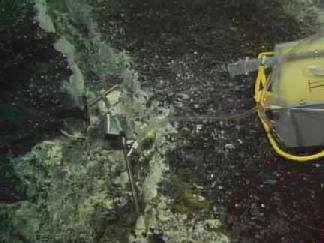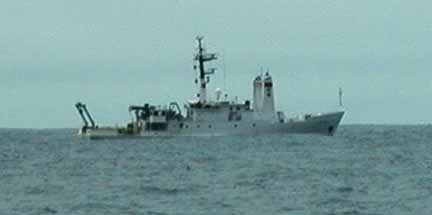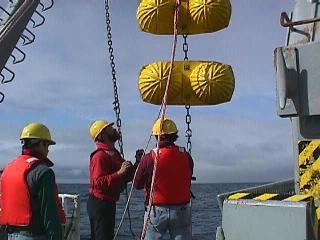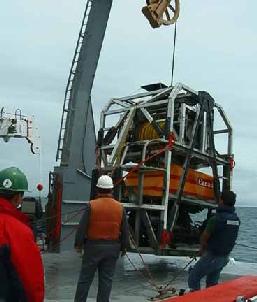WHAT'S NEW:
BACKGROUND:
Mission
Project Description
Cruise Plans:
Participants
Technology (ROV, ships, etc.)
Future Plans
Results:
1998 NeMO Cruise
Axial 1998 "Eruption"
Logbook
June 23, 1999
June 23, 1999
Contents:
- News from Thompson
- News from Wecoma
- Participant Perspective
- Logbook from Teacher at Sea
- Question/Answer from shore to sea
Thompson Science Report
Science Report - Wednesday, June 23
Ships Location: 45 41.2/-130 04.4
 ROPOS made its first visit
to the bottom early this morning (dive 483). We dove on the most
vigorous vent site that we had found last year (Marker 33) where we had
deployed instruments, samplers, and a time-lapse
camera. What we found was that the site is still venting strongly,
and had been colonized by new animals since last summer.
In fact, a clump of tubeworms were right in front of the time-lapse camera,
which took a photo every 30 hours over the last year, so it should have
recorded their colonization and growth. ROPOS also recovered an OSMO
sampler (photo left), a temperature recorder, and several bacteria
traps that had been at the vent since last summer, but the recovery
of the time-lapse camera will wait until the next dive. We also took several
samples at the vent with the suction
sampler for chemical and biological studies. The next dive will go
back to Marker 33 to recover and redeploy more experiments there before
exploring more sites on the 1998 lava flow.
ROPOS made its first visit
to the bottom early this morning (dive 483). We dove on the most
vigorous vent site that we had found last year (Marker 33) where we had
deployed instruments, samplers, and a time-lapse
camera. What we found was that the site is still venting strongly,
and had been colonized by new animals since last summer.
In fact, a clump of tubeworms were right in front of the time-lapse camera,
which took a photo every 30 hours over the last year, so it should have
recorded their colonization and growth. ROPOS also recovered an OSMO
sampler (photo left), a temperature recorder, and several bacteria
traps that had been at the vent since last summer, but the recovery
of the time-lapse camera will wait until the next dive. We also took several
samples at the vent with the suction
sampler for chemical and biological studies. The next dive will go
back to Marker 33 to recover and redeploy more experiments there before
exploring more sites on the 1998 lava flow.
Wecoma Science Report

Photo taken from R/V Thompson on 6/22/99 at Axial Volcano site.
 Mooring recovery/deployments. One of the keystones
of NeMO is continuous monitoring of hydrothermal activity at Axial
Volcano. An integral part of that effort are underwater moorings--strings
of instruments anchored to the seafloor and supported by glass floats.
Here scientists onboard the Wecoma are busy adding a set of floats to
a mooring being deployed within the caldera of Axial Volcano. Instruments
on the mooring include current meters to record the direction and speed
of the water that disperses the hydrothermal plume, temperature and optical
sensors to monitor the intensity of the plume, and a special instrument
that continuously samples a tiny volume of plume water for later chemical
analysis. Wecoma has already retrieved 9
moorings deployed in 1998, 6 months after the eruption, and is deploying
9 more moorings that will monitor plume conditions until the summer of
2000.
Mooring recovery/deployments. One of the keystones
of NeMO is continuous monitoring of hydrothermal activity at Axial
Volcano. An integral part of that effort are underwater moorings--strings
of instruments anchored to the seafloor and supported by glass floats.
Here scientists onboard the Wecoma are busy adding a set of floats to
a mooring being deployed within the caldera of Axial Volcano. Instruments
on the mooring include current meters to record the direction and speed
of the water that disperses the hydrothermal plume, temperature and optical
sensors to monitor the intensity of the plume, and a special instrument
that continuously samples a tiny volume of plume water for later chemical
analysis. Wecoma has already retrieved 9
moorings deployed in 1998, 6 months after the eruption, and is deploying
9 more moorings that will monitor plume conditions until the summer of
2000.
Listing of all Science News postings
Life at Sea: Participant Perspective
Julie Huber
Graduate Student University of Washington
 Well, I've been
living on this ship for almost a week now and have little to show for
it except a dramatic improvement in my ping-pong game and a bizarre sleeping
schedule that keeps me awake through my midnight to 4 am watch. But that's
really not why I came out here. As a second year graduate student with
John
Baross at the University of Washington, I returned to sea this summer
to continue my research on microbial communities in diffuse fluids on
Axial Seamount.
Hydrothermal systems support an amazing variety of extremely talented
microbes- microbes that can thrive
at high pressures, high concentrations of salt and toxic metals, and of
course, since they are found in hot vent environments, high temperatures.
I am particularly interested in the types of microorganisms living in
diffuse flow, which is a mixture of hot hydrothermal fluid and cold seawater
circulating through the ocean crust. Axial Seamount is an excellent place
to study microbes in diffuse fluids due to the volcanic events occurring
here which potentially bring microorganisms and fluids from the subsurface
biosphere to the seafloor where they can be sampled. So along with Dave
Butterfield, a chemist at NOAA/PMEL,
I am trying to quantify the diversity of microbes and their metabolisms
in relation to the chemistry of the diffuse fluids. I spend a lot of time
exploring new vent sites and trying to culture interesting bugs that grow
at high temperature under different nutritional conditions. We also use
a variety of molecular tools to take a closer look at the microbial community
structure and distribution of certain individuals in the diffuse fluids.
Not only does this research allow us to better understand the interactions
between microbes and hydrothermal fluids, it also lets us peer into the
subsurface seafloor environment and determine how these subsurface biotopes
may be related to one another, if at all. Last year at Axial we did extensive
sampling of many diffuse sites all around the volcano. The specific goal
of this year's expedition is to focus our sampling efforts on a few interesting
sites in order to determine how any changes in the fluid chemistry over
the past year may be reflected in the microbial community structure. Most
of my samples will be collected with the Vent
Fluid Sampler, a gem of a collection device for microbiologists and
chemists alike. For now, though, ROPOS is diving with the Biobox
to collect tubeworms and traps and other macro-objects. Meanwhile, I'm
watching porpoises play in the
bow and working on my backspin as I wait for the subsurface exploring
to begin.
Well, I've been
living on this ship for almost a week now and have little to show for
it except a dramatic improvement in my ping-pong game and a bizarre sleeping
schedule that keeps me awake through my midnight to 4 am watch. But that's
really not why I came out here. As a second year graduate student with
John
Baross at the University of Washington, I returned to sea this summer
to continue my research on microbial communities in diffuse fluids on
Axial Seamount.
Hydrothermal systems support an amazing variety of extremely talented
microbes- microbes that can thrive
at high pressures, high concentrations of salt and toxic metals, and of
course, since they are found in hot vent environments, high temperatures.
I am particularly interested in the types of microorganisms living in
diffuse flow, which is a mixture of hot hydrothermal fluid and cold seawater
circulating through the ocean crust. Axial Seamount is an excellent place
to study microbes in diffuse fluids due to the volcanic events occurring
here which potentially bring microorganisms and fluids from the subsurface
biosphere to the seafloor where they can be sampled. So along with Dave
Butterfield, a chemist at NOAA/PMEL,
I am trying to quantify the diversity of microbes and their metabolisms
in relation to the chemistry of the diffuse fluids. I spend a lot of time
exploring new vent sites and trying to culture interesting bugs that grow
at high temperature under different nutritional conditions. We also use
a variety of molecular tools to take a closer look at the microbial community
structure and distribution of certain individuals in the diffuse fluids.
Not only does this research allow us to better understand the interactions
between microbes and hydrothermal fluids, it also lets us peer into the
subsurface seafloor environment and determine how these subsurface biotopes
may be related to one another, if at all. Last year at Axial we did extensive
sampling of many diffuse sites all around the volcano. The specific goal
of this year's expedition is to focus our sampling efforts on a few interesting
sites in order to determine how any changes in the fluid chemistry over
the past year may be reflected in the microbial community structure. Most
of my samples will be collected with the Vent
Fluid Sampler, a gem of a collection device for microbiologists and
chemists alike. For now, though, ROPOS is diving with the Biobox
to collect tubeworms and traps and other macro-objects. Meanwhile, I'm
watching porpoises play in the
bow and working on my backspin as I wait for the subsurface exploring
to begin.
Listing of all Perspectives postings
Teacher At Sea Logbook
Day 8, Wednesday 06/23/99 
This morning's schedule kept all aboard busy with deployments. The crew and scientists worked together to place three moorings on the bottom before lunch. Each mooring is made up of a variety of instrument packages. The instruments will monitor selected parameters at selected depths. The instruments measure water temperature, current direction and speed, as well as particles in the water column. In addition to the NOAA/PMEL equipment, Monterey Bay Aquarium Research Institute (MBARI) of California has sent out two OSMO samplers to be added to the mooring's line. This instrument will store small samples of water in a plastic tube system within the unit. A chemical analysis will later be done on this seawater. It will be a year before these moorings will be collected and the data added to the permanent record of activity here at the vent site. Scientists can learn a great deal about the vent site and plumes with the instruments deployed by the NOAA/PMEL EOI Program. The New Millenium Observatory (NeMO) is definitely an advantage to the research and investigations taking place here at Juan de Fuca Ridge. Scientists all over the world share information to help prove the importance of volcanic eruptions and earthquakes on the mid-ocean ridges to these unique eco-systems. We have a great deal to learn.
To recover the mooring lines with all of the equipment an acoustic release is placed near the bottom of the line. When the research ship returns for collection, the release is tripped by activating the unit with an acoustic impulse, similar to a garage door opener. The large bright yellow, plastic "hard hats" that contain 17 inch glass balls pop the mooring line with instruments connected to the surface. The data is then read by ship's computer for later analysis. Each MTR, MAPR and current meter is calibrated, battery changed and checked out. Then the mooring cycle begins again.
Two thirty ft. Fin Whales cruised off our bow on the starboard side at 16:38 (4:38 pm). Their smooth dark bodies traveled close together within 70 yards of the ship. The Captain reduced speed after sighting the whales. You could make out the line of the mouth and eye as they moved towards us within 50 ft of the ship. They then sounded and continued to swim away in the open ocean. For me, another exciting moment aboard the Wecoma.
Dall's porpoise joined us to play in our wake as the first sunset of our eight day voyage was visible on the horizon. Tomorrow we will complete our work on the vent site with two more tow-yo's. Dr Richard Feely has stated that this will give us a uniform geographic distribution here on the Juan de Fuca Ridge. Join us!
Fair seas,
Ms Deck
Teachers Log #4 6/23/99
 Dive #R483
finally got under way at 03:30 this morning with ROPOS
reaching the targeted site known as Marker #33 at about 04:45. At 1500
meters depth, it takes a little over an hour for the sub to reach the
bottom. The goals for this first dive were to make a video survey of site
#33 before disturbing it by sampling specimens, to retrieve equipment
left from the 1998
cruise and to deploy new equipment for current research projects.
After the survey was completed, ROPOS was to go about making the necessary
sample collections of vent fluids, gases and life forms. The final part
of the dive before further exploration of the this area and possibly other
sites close by was to deploy osmotic
fluid samplers and analyzers along with bacterial
traps and bioboxes
and retrieve similar equipment left from a previous cruise. Scientists
were optimistic that this could be a long lasting dive that could accomplish
quite a bit of work.
Dive #R483
finally got under way at 03:30 this morning with ROPOS
reaching the targeted site known as Marker #33 at about 04:45. At 1500
meters depth, it takes a little over an hour for the sub to reach the
bottom. The goals for this first dive were to make a video survey of site
#33 before disturbing it by sampling specimens, to retrieve equipment
left from the 1998
cruise and to deploy new equipment for current research projects.
After the survey was completed, ROPOS was to go about making the necessary
sample collections of vent fluids, gases and life forms. The final part
of the dive before further exploration of the this area and possibly other
sites close by was to deploy osmotic
fluid samplers and analyzers along with bacterial
traps and bioboxes
and retrieve similar equipment left from a previous cruise. Scientists
were optimistic that this could be a long lasting dive that could accomplish
quite a bit of work.
At first ROPOS showed no ill effects of being kept onboard the ship for longer then anticipated. The dive began quite smoothly. After an initial survey of the site it was decided that samples of organisms would be made using the "slurp gun". The slurp gun is a suction-type of device that looks like a vacuum cleaner hose connected to a vacuum system. It is used for collecting samples of bacteria, gastropods (snail like animals), polynoids (scale worms) and tubeworms. One arm of ROPOS is specially configured with the vacuum hose and it is brought into close proximity to the desired group of organisms. After being ingested into the system they are directed toward a specific collection bottle where they remain until ROPOS returns to the deck of the ship. Sometimes too much is ingested and clogs develop. This is what happened today and unfortunately it stopped all suction sampling. No fretting the small problems, ROPOS went about collecting a small bush of tubeworms using the special articulating "claw". These specimens were then placed in bioboxes at the front of ROPOS. There they stayed until they reached the surface and scientists removed them for study and preservation. So we had one small glitch in the collection process but science continues on.
Before deploying the various samplers and analyzers, vent fluid was collected in order to measure the amount of particular gases and isotopes, specifically helium. Inserting the probe end of a gas-fluid collector into the vent using a robotic "claw" may appear to be easy, but just try it controlling a robot arm some 1500 m away where depth perception on a video screen is limited and you get no sense of touch feedback from the system. After numerous tries, success finally occurred. Following this operation, osmosamplers and analyzers were place along the actual vent opening. An "osmo" sampler/analyzer is designed for long-term stays at vent sites. Samplers simply collect the fluid slowly over a period of a year and analyzers actually sample the water at regular intervals and analyze them right there on the bottom. Data collected from the analysis of the water sampler is kept in a water-tight unit. The two that we deployed today will be recovered in about 2 weeks and the data will be analyzed on board to determine if they actually function correctly. It the analyzers are working correctly they will both be deployed again for a stay of up to a year on the bottom. What makes these devices so unique is that they don't require battery or power source for the actual collection of the fluid sample. What powers these samplers is the natural tendency of fluid (water) to cross a membrane to balance out the concentrations of dissolved particles.
Remember the discussions of osmosis and diffusion in biology class. Take a red onion cell and place it into salt water and the red onion cell will lose water. You'll find in the center of that red onion cell a small spherical shaped red ball of dense cellular material. When you reverse this process by placing the red onion cell in fresh or distilled water, the flow of water reverses back into the cell. Well that is how these "osmo" samplers and analyzers work. They'll run continuously until the balance of dissolved particles equals out or until the very narrow tubing used clogs up. This can often be controlled by the use of a biocide agent or acidic component within the sampler that limits the metallic buildup that these microbe down here can create. Great stuff is being created to collect specific things!
Sitting today on my first watch as a frame grabber (saving still images from video images), I got to watch a true team in action, all working for the same goal of creating a successful dive. Scientists collaborated on where to go, what specific locations along the vent might provide the greatest quantity and best quality results. When questions were asked the answers were given quickly and genuinely along with examples of where on the video monitors that item, process or specimen in question could be found. No egos in the way to limit the learning process. The best part of my watch came in observing the interactions between the scientists and the ROPOS team members. For all of ROPOS' actions and abilities, behind the scene are 7 members who provide the technical skills to operate and maintain operations. For each dive two members act as pilot and copilot. The pilot flies the ROV around in liquid space, taking it wherever the scientist needs. Working closely with him is the copilot who oversees the use of the working articulated arm. These two work in unison bringing about the collective goal of each scientist whose experiment is the focus at that particular moment. The duration of a dive is directly related to the tasks to be performed, the weather, and the possibility of unforeseen problems. It was an unforeseen problem that led to aborting dive R483. During the deployment of the last osmosampler from the elevator, the tether for ROPOS became entangled and developed a kink in the line. Rather then tempt the sea gods of misfortune, ROPOS was brought back on deck. As it stands now, ROPOS needs some repair work which may include shortening the tether a bit. If the tech guys (the magnificent 7 men of ROPOS) have anything to say about, ROPOS will be ready to dive again by midnight tonight.
As for site Marker #33, we will return for completion of dive R483, which includes the recovery of our elevator and samples. Until then, we'll be moving on to other sites along Axial Volcano's ridge system. The geologists are preparing their equipment for more coring and the fluid, gas, and biological samples that have been collected are already being analyzed by the scientific staff.
Logbook of all Teacher At Sea postings
Questions & Answers
(oar.pmel.vents.webmaster@noaa.gov)